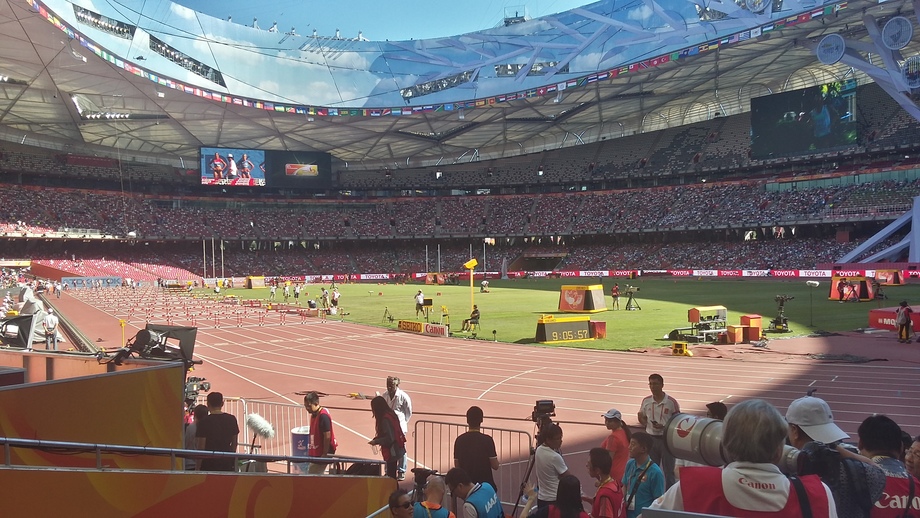
|
Commentary system used at the IAAF World Championships in Beijing 2015 relied on AoIP multichannel network solutions from AEQ. |
||
|
The IAAF World Championships, Beijing 2015 took place between 22 and 30 August 2015, was primarily hosted in the Bird’s Nest, which was the venue for the 2008 Olympic Games and is the setting for the annual IAAF World Challenge meeting. The IAAF World Championships will become the biggest sporting event on the planet when 2015 ends. 2000 athletes from over 200 nations assembled in Beijing for nine days of competitions that were broadcasted to an accumulated audience of 6 billion worldwide. AEQ provided all the Commentary Units for the fully booked commentary positions at the IAAF WC 2015 in Beijing. CCTV was acting as the Host Broadcaster (in consortium) and the Championship was held at “the Birds nest” or the National Stadium that was built for the 2008 Olympic Games. This was actually the second time that the AEQ commentary gear has been at this stadium, but on the occasion of the Olympics in 2008, the setup was in all aspects much more complicated. It was a larger system and much more complex system and the connections between the Commentary Control Unit frames (CCUs) in the Commentary Control Room (CCR), the Broadcast Compound and the International Broadcast Centre (IBC) were of a completely different scale. At that occasion we had to rely on traditional Telecoms infrastructures such as E1 Audio Multiplexer systems (also supplied by AEQ) and similar. For the IAAF WC 2015 the system was much smaller and also simplified. In the opinion of the writer it was also much more efficient in terms of what is needed in both time and resources to be deployed, thus impacting very positively in the number of man-hours required for planning, Installation, setup, operations and maintenance and eventually dismantling. |
||
|
|
||
|
The way that the Commentary System was deployed and installed was in essence the same as back in 2008, but the transport of the uni-lateral signals from the CCUs in the CCR to the Commentary Switching Centre in the IBC were significantly simplified. The CCUs in the CCR presented the unilateral commentary signals to the AEQ NetBOX 32 Audio Interfaces and network nodes. These were connected to a standard, managed gigabit switch with fibre links. Two redundant and diverse dark-fiber paths linked the CCR with the Commentary Switching Centre (CSC) in the combined IBC/Broadcast Compound and where a pairing set of managed switch and NetBox 32's. From here the signals are distributed to the RHBs in Analogue or Digital. AEQ and the Host Broadcaster would have loved to be able to give them a port on a standard Gigabit Network Switch, but there are still a few RHBs that don’t have AES67 or DANTETM compatible equipment and the HB rate-card did not include this option. Since the system is bi-directional there was obviously a return path from the RHBs IBC facilities to the CCR via the commentary Switching Centre. |
||
|
AEQ DCS10 Commentary Unit |
Commentary Signal Switching in IBC with AEQ NetBOX 32 |
|
In order to control and monitor the system signals, DANTETM Controllers and DANTETM Virtual Sound cards on computers were used at both locations (CCR and CSC), This allowed for both the control of the signal paths and to monitor the commentary signals Program Go and F'back, Coordination Go and F'back, International Sound, Auxiliar, Guide, etc. Further the International Sound (IS1 for TV and IS2 for Radio) for the commentators was produced in the Compound and was conveyed to the the CCR using the same signal path as the RHB coordination and return signals. All the other required signals that were also common signals for the commentator, such as PA and also two CUE signals were also available through this DANTETM Multichannel IP Audio Network. Installation of the Commentary Control Room (CCR) with AEQ Stratos IP and ISDN codecs and NetBOX 32 for IBC multichannel AoIP interconnectivity. |
||
|
Part of the international PoP was located in the same area as the CCR. And weather or not the RHBs were using ISDN or IP connectivity or not , all the signals were coming on the same signal path as previously described and were routed to the AEQ Phoenix Stratos IP and ISDN codecs. This part of the system provided for the International connectivity of the Commentary signal and bi-directional program and coordination with the RHB facilities in the IBC and the Commentary positions in the stadium. The beauty of the system is that it can be built as a very simple "isolated" network, where the system clock is generated by one of the NetBox 32’s. The same network was also used for control and management of for example the commentary control unit frames, the AEQ Phoenix Stratos multi-format AudioCodecs - including signal monitoring. With full control of this network it is very simple to establish the necessary responsibility demarcation points. For the setting-up, testing and operations, AEQ sent two of its engineers, Luis Hernandez and Javier Muriel to lead and assist the teams of the Host Broadcaster and its main contractor - CSS-Group at the Beijing national stadium. These companies undertook the tasks to provide the services and broadcast signals to the world broadcasting community with great professionalism. From these lines we would like to express its gratitude to CCTV as the acting host broadcaster and CSS-group for the trust deposited in AEQ. |
||












